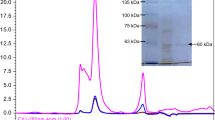Abstract
His354 and His358, two highly conserved histidines in Xenopus laevis (6-4) photolyase [equivalent to His401 and His405, in Dunaliella salina (6-4) photolyase], are critical for photoreactivation. They act as a base and an acid, respectively. However, the remaining high repair activity when the pH value is higher than the pKa of histidine suggests the involvement of other basic amino acids in photoreactivation. According to the results of in vivo enzyme assay and three-dimension structural model of Dunaliella salina (6-4) photolyase we hypothesized that Lys281 might be involved in the photoreactivation over the pH range from 10.0 to 11.0. To test this, we generated two mutant forms of the (6-4) photolyase, K281G and K281R mutant, by overlap extension polymerase chain reaction, and performed the enzyme assay with these mutants. From these results we conclude that the Lys281, which is highly conserved in (6-4) photolyases, participates in the photoreactivation and acts as an acid to donate a proton to His401 when the environmental pH is higher than the pKa value of histidine.



Similar content being viewed by others
References
Hitomi K, Kim ST, Iwai S, Harima N, Otoshi E, Ikenaga M, Todo T (1997) Binding and catalytic properties of Xenopus (6–4) photolyase. J Biol Chem 272:32591–32598
Hitomi K, Nakamura H, Kim ST, Mizukoshi T, Ishikawa T, Iwai S, Todo T (2001) Role of two histidines in the (6–4) photolyase reaction. J Biol Chem 276:10103–10109
Hitomi K, DiTacchio L, Arvai AS, Yamamoto J, Kim ST, Todo T, Tainer JA, Iwai S, Panda S, Getzoff ED (2009) Functional motifs in the (6–4) photolyase crystal structure make a comparative framework for DNA repair photolyases and clock cryptochromes. Proc Natl Acad Sci USA 106:6962–6967
Kim ST, Malhotra K, Smith CA, Taylor JS, Sancar A (1994) Characterization of (6–4) photoproduct DNA photolyase. J Biol Chem 269:8535–8540
Kobayashi Y, Ishikawa T, Hirayama J, Daiyasu H, Kanai S, Toh H, Fukuda I, Tsujimura T, Terada N, Kamei Y, Yuba S, Iwai S, Todo T (2000) Molecular analysis of zebrafish photolyase/cryptochrome family: two types of cryptochromes present in zebrafish. Genes Cells 5:725–738
Lee J, Lee HJ, Shin MK, Ryu WS (2004) Versatile PCR-mediated insertion or deletion mutagenesis. Biotechniques 36:398–400
Lo HL, Nakajima S, Ma L, Walter B, Yasui A, Ethell DW, Owen LB (2005) Differential biologic effects of CPD and 6–4PP UV-induced DNA damage on the induction of apoptosis and cell-cycle arrest. BMC Cancer 5:135–143
Lv XY, Qiao DR, Xiong Y, Xu H, You FF, He X, Cao Y (2008) Photoreactivation of (6–4) photolyase in Dunaliella salina. FEMS Microbiol Lett 283:42–46
Maul MJ, Barends TR, Glas AF, Cryle MJ, Domratcheva T, Schneider S, Schlichting I, Carell T (2008) Crystal structure and mechanism of a DNA (6–4) photolyase. Angew Chem Int Ed 47:10076–10080
McCready S, Marcello L (2003) Repair of UV damage in Halobacterium salinarum. Biochem Soc Trans 31:694–698
Nakajima S, Sugiyama M, Iwai S, Hitomi K, Otoshi E, Kim ST, Jiang CZ, Todo T, Britt AB, Yamamoto K (1998) Cloning and characterization of a gene (UVR3) required for photorepair of 6–4 photoproducts in Arabidopsis thaliana. Nucleic Acids Res 26:638–644
Pick U, Karni L, Avron M (1986) Determination of ion content and ion fluxes in the halotolerant alga Dunaliella salina. Plant Physiol 81:92–96
Sancar A (2008) Structure and function of photolyase and in vivo enzymology: 50th anniversary. J Biol Chem 283:32153–32157
Schleicher E, Hitomi K, Kay CW, Getzoff ED, Todo T, Weber S (2007) Electron nuclear double resonance differentiates complementary roles for active site histidines in (6–4) photolyase. J Biol Chem 282:4738–4747
Schroder HC, Krasko A, Gundacker D, Leys SP, Muller IM, Muller WE (2003) Molecular and functional analysis of the (6–4) photolyase from the hexactinellid Aphrocallistes vastus. Biochim Biophys Acta 1651:41–49
Schwede T, Kopp J, Guex N, Peitsch MC (2003) SWISS-MODEL: an automated protein homology-modeling server. Nucleic Acids Res 31:3381–3385
Todo T, Takemori H, Ryo H, Ihara M, Matsunaga T, Nikaido O, Sato K, Nomura T (1993) A new photoreactivating enzyme that specifically repairs ultraviolet light-induced (6–4)photoproducts. Nature 361:371–374
Todo T, Kim ST, Hitomi K, Otoshi E, Inui T, Morioka H, Kobayashi H, Ohtsuka E, Toh H, Ikenaga M (1997) Flavin adenine dinucleotide as a chromophore of the Xenopus (6–4)photolyase. Nucleic Acids Res 25:764–768
Waterworth WM, Jiang Q, West CE, Nikaido M, Bray CM (2002) Characterization of Arabidopsis photolyase enzymes and analysis of their role in protection from ultraviolet-B radiation. J Exp Bot 53:1005–1015
Weber S (2005) Light-driven enzymatic catalysis of DNA repair: a review of recent biophysical studies on photolyase. Biochim Biophys Acta 1707:1–23
Wood RD (1996) DNA repair in eukaryotes. Annu Rev Biochem 65:135–167
Yi Y, Yi C, Qian L, Min L, Long C, Linhan B, Zhirong Y, Dairong Q (2006) Cloning and sequence analysis of the gene encoding (6–4)photolyase from Dunaliella salina. Biotechnol Lett 28:309–314
Zhao X, Liu J, Hsu DS, Zhao S, Taylor JS, Sancar A (1997) Reaction mechanism of (6–4) photolyase. J Biol Chem 272:32580–32590
Acknowledgments
This study was supported by The National Natural Science Foundation of China (30871321, 30771312, and 30971817), The National Secial Basic Research Projects of China (SB2007FY400-4), and The National Basic Research Program of China (2009CB125910).
Author information
Authors and Affiliations
Corresponding author
Rights and permissions
About this article
Cite this article
Zhang, F., Xu, H., Cao, Y. et al. Role of Lys281 in the Dunaliella salina (6-4) Photolyase Reaction. Curr Microbiol 62, 146–151 (2011). https://doi.org/10.1007/s00284-010-9687-1
Received:
Accepted:
Published:
Issue Date:
DOI: https://doi.org/10.1007/s00284-010-9687-1




